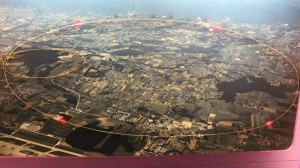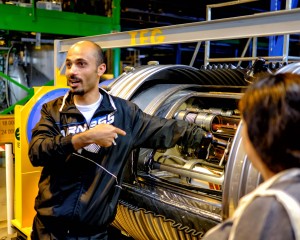June 14, 2014
Trip to CERN: June 2014
Report by Mike Meynell
There can’t be many astronomy societies that can boast of having arranged two trips to CERN in Geneva within a year! However, following on from the huge success of our first trip in September 2013, we decided to run a second trip in order to meet the obvious demand from Flamsteed members. Once again, 24 Flamsteed members made the pilgrimage to Geneva for a tour of the CERN site – a different crowd this time (apart from myself!), and everyone in the Flamsteed group got on really well with each other.
Our tour took on a very similar complexion to our first trip. We met at CERN reception, initially to visit the permanent exhibitions “Microcosm” and “Universe of Particles”. However, my first task was to check us in at reception and find out what tours we would be taken on in the afternoon. The receptionist at CERN was incredibly apologetic. “No”, she informed me, there was “no possibility” of getting underground to see the particle detectors. I was about to get on bended knee and beg, but she then confessed the reason… “the lifts are broken”. Rather amusing really… a multi-billion Euro facility, and the lifts don’t work. Ah well, it happens in the best of places, I suppose! I then had the sorry task of communicating this to our group. And what a stoic bunch they were; they hid their disappointment with only a few mumbles and groans! The consolation was that we would get to tour two over-ground facilities, the Superconducting Magnet Test Facility and the ATLAS Control Room.
Our group was then left to their own devices until lunchtime, to tour the two permanent exhibitions. I’ve written about these exhibitions before, but suffice to say that they are well worth a visit in their own right. If you find yourself in Geneva and at a loose end for half-a-day, you wouldn’t go far wrong by catching a number 18 tram to the end of the line at CERN and spending some time in these exhibitions. There is no charge to visit CERN… as I never tire of saying, if you are a taxpayer, you’ve already paid for it!
A video of the excellent 5-minute presentation that is run every hour in the “Universe of Particles” exhibition is shown below.
Lunch was in the CERN restaurant, which means passing through the security barriers. Fortunately, unlike our first visit, we were escorted to the restaurant, rather than be left to roam freely in the corridors getting increasingly lost! They have a somewhat bizarre rule in the restaurant… you can pay for your lunch in Euros, but you get your change in Swiss Francs! Technically, we were just about on the Swiss side of the border, so I suppose this makes sense… even though France was probably less than 100 metres away from where we were sitting!
After lunch, it was time for our guided tour of CERN to commence. First of all, we had a 45-minute lecture about CERN. Our speaker was a CERN engineer rather than a particle physicist, who had worked on the design of the superconducting magnets, so we got a fascinating insight into the practical aspects of how CERN was designed.
After this talk, we were taken by coach across the border into France to visit the Superconducting Magnet Test Facility. This area is used to test magnets at very low temperatures (1.9K) and high currents (20kA) for the accelerator. The low temperature makes the magnets super-conducting, so the facility is used to ‘train’ the magnets before they are installed in the LHC. Our guide for this tour was Mohammed, who was a real character and incredibly knowledgeable. I’m grateful to Linden Davis for the videos that he took of this tour, an edited version of which you can see below.
After the magnets facility, we boarded the coach again to take us back into Switzerland to visit the ATLAS control room. The ATLAS detector itself is about the size of a small tower block – 45 metres long, 25 metres in diameter and weighing 7,000 tons. You can see how large this is, as a scale model of the detector is depicted on the side of the ATLAS control centre. Engineering on an epic scale. When two elementary particles collide in the ATLAS detector a variety of different particles with a broad range of energies are produced. In the ATLAS detector, there are about a billion collision events per second.
At the end of the tour, we were briefly stranded in the ATLAS building, as there was a huge thunderstorm outside. A relatively common occurrence in the late afternoon in Geneva in the summer months, but the rain soon eased enough for us to make a run for the tram stop.
A few people couldn’t join the group for dinner in the evening, but we still had 20 people for dinner at the Café du Soleil, a restaurant that did us proud on the first trip and was certainly worth a return visit. Once again it was a great success… the food was very good, and our group of Flamsteed members had a thoroughly good evening out.
So ended our second trip to CERN. The feedback I’ve received from our group has been tremendous, with everyone seeming to thoroughly enjoy the trip.
Should we organize a third trip? This is a difficult one. We learnt that the current long shut down period is on schedule, so the LHC will begin power-up tests in August. This means that access underground will, once again, be restricted. The next “long shut down” is planned for 2018… so we may concentrate on other locations for trips until that long distant date! Certainly, there is a strong appetite amongst members for more society trips. I was asked continually what we were thinking of organising next! Any suggestions gratefully received!!
My thanks to everyone in the Flamsteed group for making this trip such a success. You were all great company and it was a pleasure to spend some time with you all in Geneva.
Pictures from the trip (by Anne Lane, Glenda Acerbi and Mike Meynell):
Posted under: Flamsteed, Society Trip

























You must be logged in to post a comment.